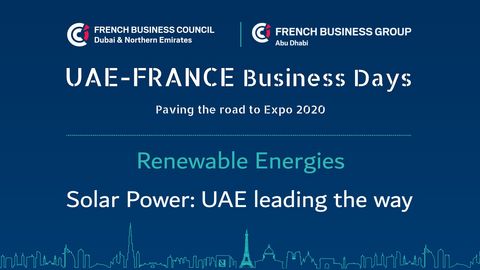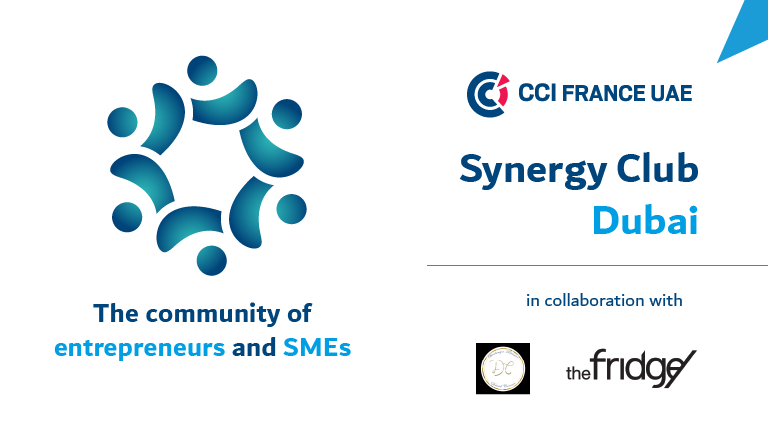Evènements Secteur d'activité • Energies renouvelables - Développement durable - Environnement
[Replay] Solar Power: UAE leading the way

Speakers
- Renaud Capris, Chief Executive - Enova
- Marin de Montbel Managing Director Total Solar Distributed Generation ME
- Mohammad Abdelqader El Ramahi - Director, Asset Management and Technical Services, Clean Energy, Masdar
- Riad Bestani, Senior Advisor Sustainability, InterBKonsult
Key Takeaways
The region has huge potential for Solar Energy development and the UAE is definitely leading the way thanks to a perfect mix of
- Good regulation
- Easy access to green energy
- A good price
- And innovation and digitalization
Solar energy is, from a natural resource point of view, the most available in terms of potential generation capacity / megawatt / year. This covers both types of solar: the concentrated solar power that depends on the dni (direct nominal irradiation), and the pv which depends on the ghi (horizontal radiation). Solar photovoltaic is one of the key energy conservation measures used to reduce carbon footprint.
French expertise and reputation in solar energy technology in the region is carried by Total, Engie and EDF but also a lot of French SMEs who bring excellent technology and knowledge.
Having strong players like Total being experienced and settled in the region is a big advantage and a big boost to the solar industry. Companies that may not be able to do the original investment in solar can rely on big players to build and maintain a system for the long term. If you just invest but don't maintain the system for 20 years it will not be as productive so it is essential to have credible and strong players and the last 2 years have seen a huge increase in B2B business and solar rooftop activity.
All residential developers now include solar in their new project even in the retrofitting one. Rooftop photovoltaics is definitively a trend and a commitment taken by all large developers in the uae.
Prices of pv have drastically gone down from 7 $ to 1.3/ 1.4 $ and some predict that within one or two years it will reach 1$/kilowatt hour thanks to economy of scale due to availability of natural resources and more importantly because photovoltaic is now becoming dispatchable as the storage technology is evolving and battery storage is becoming more and more available. Solar will not only be considered as a complementary source of energy, but it will compete with conventional sources of energy.
The main drivers to reducing costs are:
- developers working to drive the prices down through optimization, value engineering, and by unbundling rebundling through technology revolution and development.
- financing through banks and financial institutions who play a key role through scale of deployment
- governance governments help through regulations to facilitate renewable energy projects
- various logistical and regulatory frameworks that cut the cost of land taxation
Technologies are really stepping forward in terms of efficiency optimization and cost.
Masdar partners with EDF on a number of projects in the UAE and they successfully bid to develop a project with hybrid solar pv and csp and storage. This project is a game changer not because of the hybridization itself but because it drastically reduces the cost of generation of electricity with the use of storage.
Digitalization is going to be an accelerator in the development of Solar Energy: it is usually focused on operation and maintenance through the use of drones for inspections for instance. There are also solutions developed to keep the same efficiency of projects for 15 20 years.
Solar is becoming an integral part of solar powered sustainable water desalination because it is now a part of the future of membrane desalination.
Esco: energy service companies that provide energy optimization and efficient enhancements are really key to help reduce the power consumption and improve the cost of energy at various categories of customer consumption whether large-scale domestic like compounds or even industrial and commercial facilities.
Ipp: the independent power producers which is a no capex cost to the customer the lenders and financial communities are key because they help level the cost of electricity through pushing the cost of finance down and increasing the affordability of the cost of generation of electricity.
Innovation is key for storage, for example hydrogen storage is something that will be the revolution even for solar in the future with huge investment made in France for instance.
The pandemic has meant that a lot of companies struggling financially have needed to reduce their energy costs. It has also seen an increase in interest for green power and environmental concerns so solar energy can help companies make energy cost savings and help them with their marketing and brand image. Before Covid clients were looking to invest their own equity on projects but they are now looking for savings without investing their capex.
Clients are looking for a global solution including turnkey epc and financing more than looking for a specific program. That’s why they go for developers who will be in charge of finding the right epc to develop it, find the right company to maintain the system and raise funds to finance the project.
R&D is an essential part of the UAE strategy in renewables to cover the whole value chain. Masdar City is a prime example of that, being a tech hub/ a large scale laboratory to demonstrate these research, to develop technologies on the ground and incubate these technologies that are evolving and maturing into a commercial implication. It also is a place to do commercial deployment to help make these technologies available and affordable.




